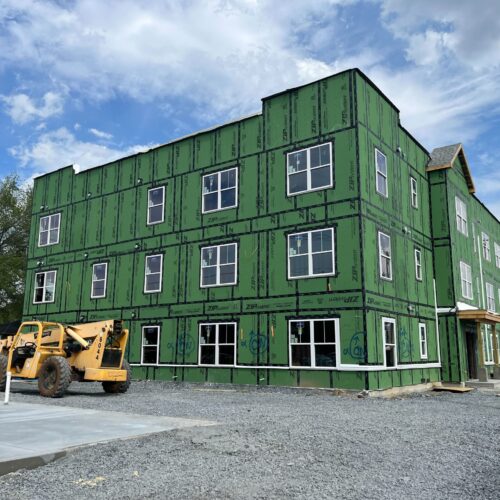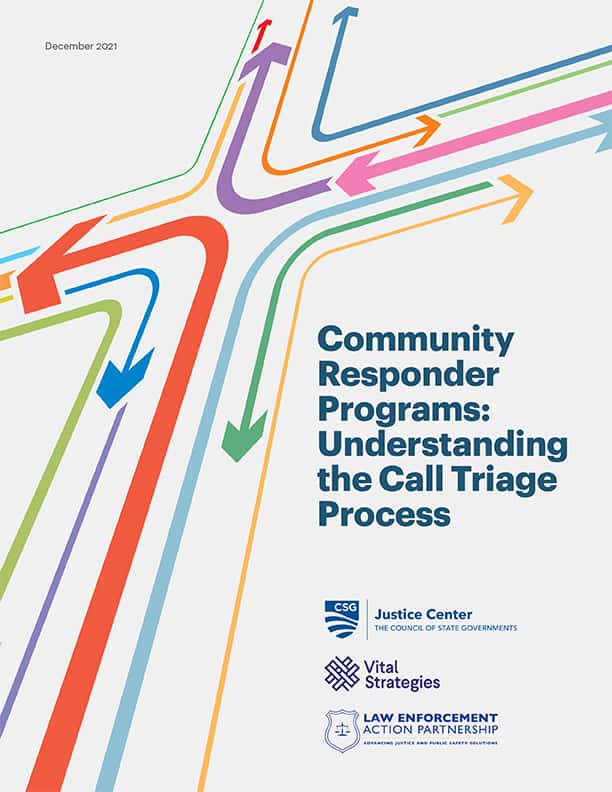Community Responder Programs: Understanding the Call Triage Process
Community responder programs are an increasingly common component of local emergency response systems across the country. Often used to respond to mental health and substance use (i.e., behavioral health) crises and social disturbances, these health professionals and trained crisis staff provide immediate assistance to people in crisis, facilitate connections to support services, conduct wellness checks, and more. One challenging aspect of implementing such a program, however, is ensuring that community responders are included in the local call triage process(es) so that emergency call centers can identify and relay appropriate calls to them. This brief highlights the different ways call triage can be used to inform and dispatch community responders. Photo by RODNAE Productions via Pexal
Community responder programs are an increasingly common component of local emergency response systems across the country and are conceived as an expansion of the first responder system. Often used to respond to mental health and substance use (i.e., behavioral health) crises and social disturbances, these health professionals and staff trained in crisis response provide immediate assistance to people in crisis, facilitate connections to support services, conduct wellness checks, and more.
One challenging aspect of implementing such a program, however, is ensuring that community responders are included in the local call triage process(es)1 so that emergency call centers can identify and relay appropriate calls to them.
For some, this may mean integrating community responders into existing 911 and emergency protocols. Other jurisdictions may decide to set up a new emergency phone number, a crisis line, or utilize the newly established national 988 crisis number and implement a call triage process specific to community responders. When done effectively, call triage can ensure that community responders receive the information they need to safely address a situation. It can also protect community members from receiving an unnecessary police response.
This brief highlights the different ways call triage can be used to inform and dispatch community responders. While most jurisdictions will ultimately create multiple opportunities for calls to be triaged and directed to community responders, many will likely begin with one approach to call triage until more resources are available. Below are the two most common approaches:
1. Connecting Community Responders through Calls that Begin with 911
The most common way that people call for help is by dialing 911. Therefore, any call triage process used to connect people to community responders, whether newly established or existing, should involve 911 operations. This may include 911 receiving a call for service and rerouting it to a different number such as 211, 311, a crisis line, or 988, or it could include 911 call takers directly routing calls to community responders.2
When someone dials 911 for an emergency, the call is automatically sent to that caller’s nearest public safety answering point (PSAP)—an emergency call center employed by the county sheriff, police or fire department, or a stand-alone communications agency. In most emergency call centers, a call taker answers 911 and enters notes into the call file that is then used by dispatch to assign calls to first responders (see Dispatching Responders section). Community responder teams will want to be added to call taker options at this point in any triage process so that they can respond to calls in a timely manner.
Screening Calls
As part of this triage, 911 call takers should use screening questions to help identify calls and determine the most appropriate response. Some answers to these questions may indicate a need for a police or emergency medical services (EMS) response instead of a community responder, especially if there is a threat of violence, possession of a weapon, or need of emergency medical care. However, conducting screening at the moment someone dials 911 can allow call takers to connect people with community responders as a police alternative when appropriate, especially if the person directly asks for the community responder program by name.3
Some communities have added screening questions to further help call takers distinguish whether the person is calling about a mental health or substance use crisis. For a substance use crisis, in particular, call takers will need to identify if the crisis is related to overdose, acute intoxication, or withdrawal requiring medical monitoring. These kinds of screening questions can help call takers determine whether community responders or an EMS response would be the most appropriate in these instances. Call takers should know that it may be difficult for the caller to be able to identify differences between a mental health crisis and a substance use crisis as some of their symptoms overlap. Call takers can potentially be trained to understand and recognize substance-specific information depending on community needs to help when the caller cannot identify the need themselves.4 For example, if methamphetamine or opioid use rates are high in a community, then identifying whether these are present in the crisis call can be built into the processes for community responders and health first response options.
Dispatching Responders
In many jurisdictions, dispatchers (whether police, fire, or EMS) are the people who relay call takers’ notes to officers and emergency personnel based on their assessed priority levels. Often, dispatchers will assign calls to specific squad cars or fire departments. They may also allow a call to be “self-dispatched,” especially for low-priority calls, meaning that a dispatcher waits for an available unit to claim the call. In jurisdictions with community responders, dispatchers can triage calls and redirect them to community responders instead of police officers or emergency personnel.
To triage calls at this entry point, dispatchers will receive the call file from the 911 call taker, who is speaking to the caller and has screened the call to determine that it can be routed to a community responder. While community responders can handle a wide range of calls, mental health and substance use calls, in particular, are sometimes dispatched using two other methods:
1. Through embedded clinicians: Prior to police, fire, or EMS dispatch receiving a call for service, a call taker who has already triaged the call may decide to forward assessed calls to a behavioral health clinician embedded in the call center. This call will usually be done through a “warm handoff” (i.e., all information is included). At this point, the embedded clinician, who has the expertise to recognize signs of mental health and substance use issues over the phone, acts as a dispatcher and is responsible for deciding whether to send community responders to address the call, handle the call themselves, or reroute the call to police, fire, or EMS.
2. Redirecting to outside agency personnel: Using the triage process, call takers may forward calls to an external service provider, such as a crisis hotline. This provider, which handles both the call-taking and dispatch services, will have an opportunity to redirect calls to community responders or to police, fire, or EMS based on their own screening questions.
Fig. 1. Dispatch Model Comparison to Call Triage for Community Responders
| Type of dispatch | Benefits | Challenges |
|---|---|---|
| 911 Dispatcher | Multiple experienced call takers and dispatchers can send calls to community responders, creating more opportunities for people to receive help from the police and fire department alternative first responders.
911 call takers and dispatchers become more familiar with community responder programs and are more likely to reroute calls to them. |
It requires increased training for call takers and dispatchers.
There must be clear protocols with screening questions that are relevant for all potential situations including mental health and substance use crisis. |
| Embedded Clinician | Using embedded clinicians as dispatchers reduces the need for training all emergency call center call takers and dispatchers on a new process.
If police officers are still needed for higher risk or violent calls, embedded clinicians can be conferenced in to de-escalate and gather information to better inform officers who arrive. By sharing the same physical space, call takers get to know the clinicians and become more comfortable referring calls. They can also help train and revise screening questions for call takers who do need additional training on identification of mental health or substance use issues. Embedded clinicians will have the knowledge to identify substance- specific information to assist in the triage processes. |
It can be expensive to hire a clinician and add a new workstation.
The clinician will take on multiple roles, potentially delaying dispatches and reducing bandwidth. |
| Outside Agency Personnel | Call triaging through an outside agency with specialized knowledge can increase the expertise of the people handling calls of a specific type.
There may be opportunities to link to existing crisis or warm lines or collaborate with providers as 988 is rolled out in the United States. |
There are resource and cost constraints for jurisdictions to set up an external hotline.
It may limit the scope of community responder calls to narrowly defined mental health or substance use calls. |
2. Using a Dedicated Crisis or Non-Emergency Phone Line to Connect Callers to Community Responders
Several jurisdictions offer an alternative phone number that people can call to request community responders. This can build upon already existing infrastructure for services such as through the emergency call center, 311, 211, or crisis hotlines. Callers who distrust law enforcement may fear that a 911 call will be routed to the police, which is one potential benefit of using an alternative number. Local non-emergency lines like 311 or 211, or the upcoming national 988 crisis line, however, will require public education and community engagement, since 911 is still the most well-known and most commonly used option. Jurisdictions with dedicated alternative phone numbers will want to have a clear call triage and coordination process in place so that call takers can appropriately route calls to community responders for immediate response when necessary.
End notes
1. Triaging is the process that call takers and dispatchers use when they receive emergency and non-emergency calls from the community. This process involves analyzing, coding, organizing, sorting, and allocating calls to the appropriate first responders. It is intended to prioritize calls based on the level of urgency of the situation and to determine the most appropriate response. One of the main goals of a call triage process that includes community responders is determining when to dispatch a non-police response team for various issues including mental health crises, non-emergency medical needs, public disturbances, welfare checks, and housing crises.
2. Note that there are community responder teams who are not dispatched through 911, but the majority are.
3. There are jurisdictions that have other pre-arrest intervention options such as a co-response team or crisis intervention team (CIT) trained officers that may be sent if law enforcement is needed.
4. National Association of State Mental Health Program Directors (NASMHPD), Assessment #4: Addressing Substance Use in Behavioral Health Crisis Care: A Companion Resource to the SAMHSA Crisis Toolkit (Alexandria, VA: NASMHPD, 2020), https://www.nasmhpd.org/sites/default/files/2020paper4.pdf.
Project credits
Writing: Amos Irwin, Law Enforcement Action Partnership
Research: Amos Irwin, Law Enforcement Action Partnership
Project Manager: Amelia Vorpahl, CSG Justice Center
Advising: Jasmine Graves, Radical Imagination Strategies, and Sarah Wurzburg and Dr. Ayesha Delany-Brumsey, CSG Justice Center
Editing: Darby Baham, CSG Justice Center
Design: Michael Bierman
Web Development: eleventy marketing group
Public Affairs: Ruvi Lopez, CSG Justice Center
About the author

 Zero Returns to Homelessness Initiative Launches Nationally, with Pennsylvania Leading the Way
Read More
Zero Returns to Homelessness Initiative Launches Nationally, with Pennsylvania Leading the Way
Read More
 New Hampshire Continues Justice Reinvestment Effort to Improve Conditions for People Who Are High Utilizers of Criminal Justice and Behavioral Health Systems
Read More
New Hampshire Continues Justice Reinvestment Effort to Improve Conditions for People Who Are High Utilizers of Criminal Justice and Behavioral Health Systems
Read More















